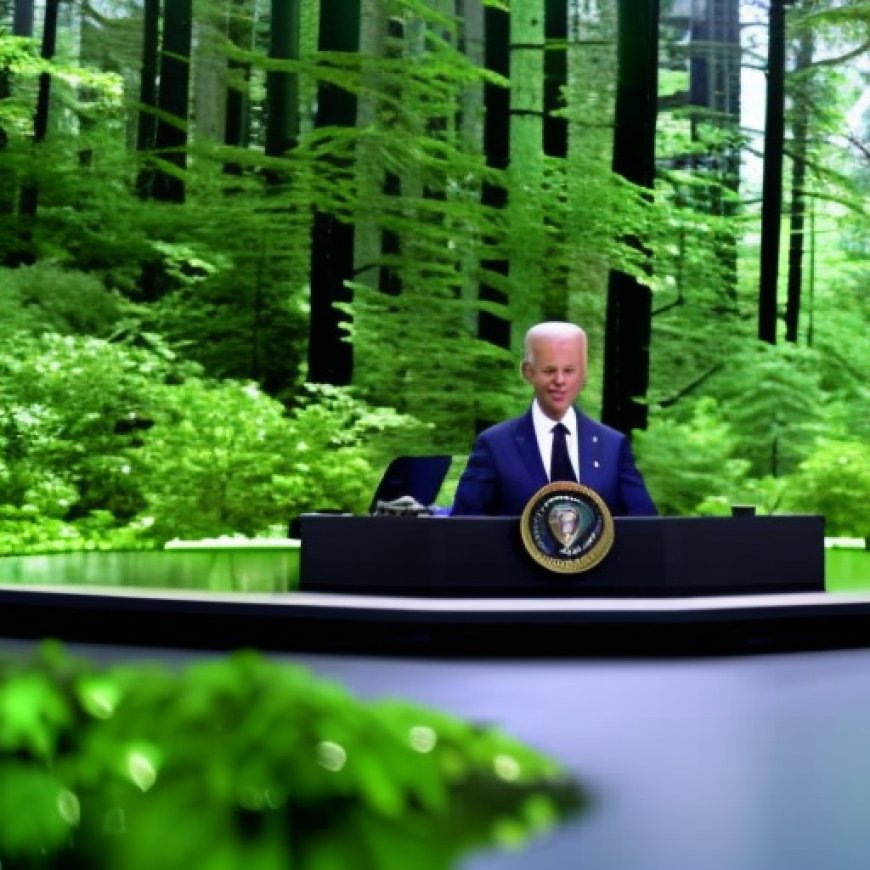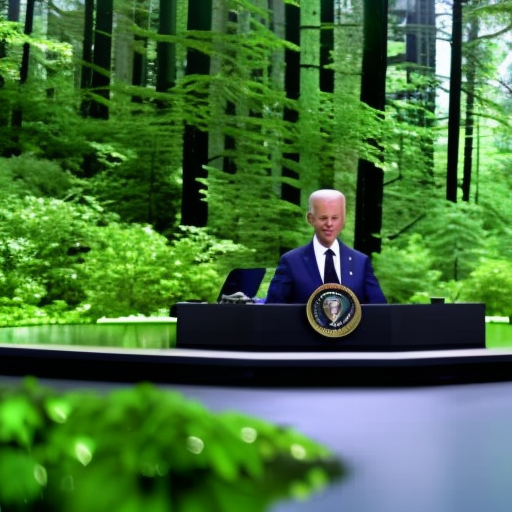Biden-Harris Administration Announces Availability of Nearly $50 Million to Strengthen Forest Products Economy, Forest Sector Jobs as part of Investing in America Agenda
Biden-Harris Administration Announces Availability of Nearly $50 ... USDA.gov


U.S. Department of Agriculture’s Forest Service Announces $50 Million Grant Funding for Sustainable Forests and Rural Economies
WASHINGTON, Oct. 18, 2023 — Today, the Biden-Harris Administration announced the U.S. Department of Agriculture’s Forest Service is making nearly $50 million in grant funding available for proposals that support crucial links between resilient, healthy forests, strong rural economies, and jobs in the forestry sector. Made possible by President Biden’s Investing in America agenda, a key pillar of Bidenomics, this funding will spark innovation, create new markets for wood products and renewable wood energy, expand processing capacity, and help tackle the climate crisis.
Investing in America Agenda and Sustainable Development Goals
This funding opportunity aligns with the Sustainable Development Goals (SDGs) set by the United Nations. By supporting sustainable forest management, renewable energy sources, and economic development in rural areas, the grants contribute to several SDGs, including:
- No Poverty
- Zero Hunger
- Good Health and Well-being
- Decent Work and Economic Growth
- Industry, Innovation, and Infrastructure
- Sustainable Cities and Communities
- Climate Action
- Life on Land
- Partnerships for the Goals
Secretary Vilsack’s Statement
“A strong forest products economy contributes to healthier forests, vibrant communities, and jobs in rural areas,” said Agriculture Secretary Tom Vilsack. “Thanks to President Biden’s Investing in America agenda, we are investing in rural economies by growing markets for forest products through sustainable forest management while reducing wildfire risk, fighting climate change, and accelerating economic development.”
Funding Opportunity and Programs
The open funding opportunity comes through the Forest Service’s three key grant programs to support the forest products economy: Wood Innovations Grant, Community Wood Grant, and Wood Products Infrastructure Assistance Grant Programs. The agency is seeking proposals that support innovative uses of wood in the construction of low carbon buildings, as a renewable energy source, and in manufacturing and processing products. These programs also provide direct support to expand and retrofit wood energy systems and wood products manufacturing facilities nationwide.
The Forest Service is requesting proposals from eligible entities in the private, non-profit, and government sectors including Tribes, local and state governments, businesses and for-profit entities, institutions of higher education, as well as public utility, fire, conservation, and school districts, among others.
Forest Health and Wildfire Risk Reduction
These investments will support forest management projects to improve forest health and reduce wildfire risk across all land ownerships. Byproducts of these activities, like small diameter timber and woody biomass, have historically been of little market value. Thanks in part to these Forest Service grant programs, funding is available to support the use of this often-unused material in many types of wood products.
Businesses that are engaged in or support the forest products economy are eligible to apply for funding to expand manufacturing capacity. These businesses are vital employers in local communities, especially in tribal or rural communities.
The investments will also support the Forest Service’s 10-year strategy to address the wildfire crisis in the places where it poses the most immediate threats to communities. The agency is investing in projects that source wood from activities that reduce risks to communities, like prescribed fire and mechanical thinning to reduce the vegetation that fuels wildfires.
Conclusion
The U.S. Department of Agriculture’s Forest Service is taking significant steps towards achieving the Sustainable Development Goals by providing $50 million in grant funding to support resilient forests, rural economies, and jobs in the forestry sector. Through the Wood Innovations Grant, Community Wood Grant, and Wood Products Infrastructure Assistance Grant Programs, the Forest Service aims to promote sustainable forest management, renewable energy sources, and economic growth. These investments will not only contribute to achieving the SDGs but also help combat climate change and build a clean energy economy nationwide.
For more information on funding opportunities and eligibility criteria, visit the Forest Service webpage.
USDA touches the lives of all Americans each day in so many positive ways. Under the Biden-Harris administration, USDA is transforming America’s food system with a greater focus on more resilient local and regional food production, fairer markets for all producers, ensuring access to safe, healthy, and nutritious food in all communities, building new markets and streams of income for farmers and producers using climate smart food and forestry practices, making historic investments in infrastructure and clean energy capabilities in rural America, and committing to equity across the Department by removing systemic barriers and building a workforce more representative of America. To learn more, visit www.usda.gov.
#
USDA is an equal opportunity provider, employer, and lender.
SDGs, Targets, and Indicators Analysis
1. Which SDGs are addressed or connected to the issues highlighted in the article?
- SDG 8: Decent Work and Economic Growth
- SDG 9: Industry, Innovation, and Infrastructure
- SDG 13: Climate Action
- SDG 15: Life on Land
The article discusses the U.S. Department of Agriculture’s Forest Service making grant funding available to support resilient forests, rural economies, and jobs in the forestry sector. This aligns with SDG 8, which aims to promote sustained, inclusive, and sustainable economic growth, full and productive employment, and decent work for all. It also connects to SDG 9, which focuses on building resilient infrastructure, promoting inclusive and sustainable industrialization, and fostering innovation. Additionally, the funding aims to tackle the climate crisis, which is a key aspect of SDG 13. Finally, the article mentions improving forest health and reducing wildfire risk, which relates to SDG 15’s goal of protecting, restoring, and promoting sustainable use of terrestrial ecosystems.
2. What specific targets under those SDGs can be identified based on the article’s content?
- Target 8.2: Achieve higher levels of economic productivity through diversification, technological upgrading, and innovation.
- Target 9.4: Upgrade infrastructure and retrofit industries to make them sustainable.
- Target 13.2: Integrate climate change measures into national policies, strategies, and planning.
- Target 15.2: Promote the implementation of sustainable management of all types of forests.
The article mentions funding that will spark innovation, create new markets for wood products and renewable wood energy, and expand processing capacity. These actions contribute to achieving Target 8.2 under SDG 8. The grants also aim to support the construction of low carbon buildings and the use of wood as a renewable energy source, aligning with Target 9.4 of SDG 9. Additionally, the funding is intended to tackle the climate crisis, which relates to Target 13.2 of SDG 13. Lastly, the grants support forest management projects to improve forest health, which contributes to achieving Target 15.2 of SDG 15.
3. Are there any indicators mentioned or implied in the article that can be used to measure progress towards the identified targets?
- Indicator 8.2.1: Annual growth rate of real GDP per employed person.
- Indicator 9.4.1: CO2 emissions per unit of value added.
- Indicator 13.2.1: Number of countries that have integrated mitigation, adaptation, impact reduction, and early warning measures into their national policies, strategies, and planning.
- Indicator 15.2.1: Progress towards sustainable forest management.
The article does not explicitly mention these indicators, but they can be used to measure progress towards the identified targets. For example, Indicator 8.2.1 can measure the economic productivity achieved through diversification and innovation mentioned in the article. Indicator 9.4.1 can assess the sustainability of industries by measuring their CO2 emissions per unit of value added. Indicator 13.2.1 can evaluate the integration of climate change measures into national policies and planning. Lastly, Indicator 15.2.1 can track progress towards sustainable forest management, which is a goal mentioned in the article.
SDGs, Targets, and Indicators Table
| SDGs | Targets | Indicators |
|---|---|---|
| SDG 8: Decent Work and Economic Growth | Target 8.2: Achieve higher levels of economic productivity through diversification, technological upgrading, and innovation. | Indicator 8.2.1: Annual growth rate of real GDP per employed person. |
| SDG 9: Industry, Innovation, and Infrastructure | Target 9.4: Upgrade infrastructure and retrofit industries to make them sustainable. | Indicator 9.4.1: CO2 emissions per unit of value added. |
| SDG 13: Climate Action | Target 13.2: Integrate climate change measures into national policies, strategies, and planning. | Indicator 13.2.1: Number of countries that have integrated mitigation, adaptation, impact reduction, and early warning measures into their national policies, strategies, and planning. |
| SDG 15: Life on Land | Target 15.2: Promote the implementation of sustainable management of all types of forests. | Indicator 15.2.1: Progress towards sustainable forest management. |
Behold! This splendid article springs forth from the wellspring of knowledge, shaped by a wondrous proprietary AI technology that delved into a vast ocean of data, illuminating the path towards the Sustainable Development Goals. Remember that all rights are reserved by SDG Investors LLC, empowering us to champion progress together.
Source: usda.gov

Join us, as fellow seekers of change, on a transformative journey at https://sdgtalks.ai/welcome, where you can become a member and actively contribute to shaping a brighter future.







